Comprehensive Optimization of the Dispersion of Mixing Particles in an Inert-Particle Spouted-Bed Reactor (IPSBR) System
Abstract
:1. Introduction
2. CFD Simulation
2.1. Simulation Configuration
2.2. CFD Model
3. Response Surface Methodology (RSM) Design
4. Results and Discussion
4.1. Impact of Independent Parameters on Average Solid Velocity Distribution
- (a)
- Effect of feed gas velocity on average solid velocity distribution
- (b)
- Effect of Orifice Diameter on Average Solid Velocity
- (c)
- Effect of gas head on average solid velocity
- (d)
- Effect of mixing particle diameter on average solid velocity
- (e)
- Effect of mixing particle load on the average solid velocity
4.2. Effect of Independent Parameters on the Average Solid Volume Fraction
- (a)
- Effect of feed gas velocity on the solid volume fraction
- (b)
- Effect of orifice diameter on solid volume fraction
- (c)
- Influence of gas head on solid volume fraction
- (d)
- Effect of mixing particle diameter on solid volume fraction
- (e)
- Effect of mixing particle load on solid volume fraction
4.3. Influences of Factors on the Mass Concentration of Mixing Particles
4.4. Influences of Factors on Average Solid Volume Fraction
4.5. Influences of Factors on Average Mixing Particle Velocity
4.6. Response Optimizer
4.7. Validation of the CCD Model
4.8. Contour Plots
4.9. Validation of the CFD Model
5. Conclusions
Supplementary Materials
Author Contributions
Funding
Acknowledgments
Conflicts of Interest
Nomenclature
| Roman letters | |
| Drag coefficient | |
| Particle diameter (m) | |
| 2DD | Two dimensional |
| Drag force (N) | |
| g | Gravity (m/s2) |
| Momentum exchange coefficient between qth and kth phases | |
| Interphase exchange forces | |
| Reynolds number | |
| Latin letters | |
| Tensor notation for velocity in i direction | |
| Tensor notation for velocity in j direction | |
| Tensor notation for space coordinates | |
| , | Turbulence model constants |
| Greek letters | |
| kth phase stress–strain tensor | |
| Average mixture velocity (gas and liquid) | |
| Fluid velocity for th phase (m/s) | |
| Abbreviations | |
| CFD | Computational fluid dynamics |
| CCD | Central composite design |
| CO2 | Carbon dioxide |
| CSTR | Continuous stirred-tank reactor |
| DM | Diameter of mixing particle |
| DPM | Discrete phase mode |
| FM | Mixing particle load |
| GH | Gas head |
| IPSBR | Inert-particles spouted-bed reactor |
| OD | Orifice diameter |
| PBM | Population balance model |
| RSM | Response surface methodology |
| Fluid velocity for th phase (m/s) | |
| Mixture molecular viscosity (Pa·s) | |
| Eddy viscosity (Pa·s) | |
| Density for phase (kg/m3) | |
| Mixture density (kg/m3) | |
| Particle density(kg/m3) | |
| K | Turbulence energy |
| ɛ | Isotropic turbulence dissipation rate |
| Particle velocity (m/s) | |
| Molecular viscosity for th phase (Pa·s) | |
| Diffusion Prandtl number for turbulence energy | |
| Diffusion Prandtl number for dissipation rate | |
References
- Konduri, R.K.; Altwicker, E.R.; Morgan, M.H., III. Design and scale-up of a spouted-bed combustor. Chem. Eng. Sci. 1999, 54, 185–204. [Google Scholar] [CrossRef]
- Jono, K.; Ichikawa, H.; Miyamoto, M.; Fukumori, Y. A review of particulate design for pharmaceutical powders and their production by spouted bed coating. Powder Technol. 2000, 113, 269–277. [Google Scholar] [CrossRef]
- Zhao, X.-L.; Li, S.; Liu, G.-Q.; Yao, Q.; Marshall, J.-S. DEM simulation of the particle dynamics in two-dimensional spouted beds. Powder Technol. 2008, 184, 205–213. [Google Scholar] [CrossRef]
- Kim, M.; Na, J.; Park, S.; Park, J.-H.; Han, C. Modeling and validation of a pilot-scale aqueous mineral carbonation reactor for carbon capture using computational fluid dynamics. Chem. Eng. Sci. 2018, 177, 301–312. [Google Scholar] [CrossRef]
- Pietsch, S.; Kieckhefen, P.; Heinrich, S.; Müller, M.; Schönherr, M.; Jäger, F.K. CFD-DEM modelling of circulation frequencies and residence times in a prismatic spouted bed. Chem. Eng. Res. Des. 2018, 132, 1105–1116. [Google Scholar] [CrossRef]
- He, Y.-L.; Qin, S.-Z.; Lim, C.J.; Grace, J.R. Particle velocity profiles and solid flow patterns in spouted beds. Can. J. Chem. Eng. 1994, 72, 561–568. [Google Scholar] [CrossRef]
- José, M.J.S.; Olazar, M.; Alvarez, S.; Izquierdo, M.A.; Bilbao, J. Solid cross-flow into the spout and particle trajectories in conical spouted beds. Chem. Eng. Sci. 1998, 53, 3561–3570. [Google Scholar] [CrossRef]
- Zhao, X.-L.; Yao, Q.; Li, S.-Q. Effects of draft tubes on particle velocity profiles in spouted beds. Chem. Eng. Technol. 2006, 29, 875–881. [Google Scholar] [CrossRef]
- Norman, E.; Grace, J.R. Spouted and Spout-Fluid Beds: Fundamentals and Applications; Cambridge University Press: Cambridge, UK, 2010. [Google Scholar]
- El-Naas, M.H.; Mohammad, A.F.; Suleiman, M.I.; Al Musharfy, M.; Al-Marzouqi, A.H. Evaluation of a novel gas-liquid contactor/reactor system for natural gas applications. J. Nat. Gas Sci. Eng. 2017, 39, 133–142. [Google Scholar] [CrossRef]
- El-Naas, M.H. System for Contacting Gases and Liquids. U.S. Patent No. 9,724,639, 8 August 2017. [Google Scholar]
- Mustafa, J.; Mourad, A.A.-H.I.; Al-Marzouqi, A.H.; El-Naas, M.H. Simultaneous treatment of reject brine and capture of carbon dioxide: A comprehensive review. Desalination 2020, 483, 114386. [Google Scholar] [CrossRef]
- Mohammad, A.F.; Mourad, A.A.-H.I.; Mustafa, J.; Al-Marzouqi, A.H.; El-Naas, M.H.; Al-Marzouqi, M.; Alnaimat, F.; Suleiman, M.I.; Al Musharfy, M.; Firmansyah, T. Computational fluid dynamics simulation of an Inert Particles Spouted Bed Reactor (IPSBR) system. Int. J. Chem. React. Eng. 2020, 18. [Google Scholar] [CrossRef]
- Mohammad, A.; Mourad, A.A.-H.I.; Al-Marzouqi, A.; El-Naas, M.H.; Van der Bruggen, B.; Al-Marzouqi, M.; Alnaimat, F.; Suleiman, M.; Al Musharfy, M. CFD and statistical approach to optimize the average air velocity and air volume fraction in an inert-particles spouted-bed reactor (IPSBR) system. Heliyon 2021, 7, e06369. [Google Scholar] [CrossRef] [PubMed]
- Su, W.; Shi, X.; Wu, Y.; Gao, J.; Lan, X. Simulation on the effect of particle on flow hydrodynamics in a slurry bed. Powder Technol. 2019, 361, 1006–1020. [Google Scholar] [CrossRef]
- Yancheshme, A.A.; Zarkesh, J.; Rashtchian, D.; Anvari, A. CFD simulation of hydrodynamic of a bubble column reactor operating in churn-turbulent regime and effect of gas inlet distribution on system characteristics. Int. J. Chem. React. Eng. 2016, 14, 213–224. [Google Scholar] [CrossRef]
- Lakhdissi, E.M.; Soleimani, I.; Guy, C.; Chaouki, J. Simultaneous effect of particle size and solid concentration on the hydrodynamics of slurry bubble column reactors. AIChE J. 2020, 66, e16813. [Google Scholar] [CrossRef]
- Sasaki, S.; Uchida, K.; Hayashi, K.; Tomiyama, A. Effects of particle concentration and slurry height on gas holdup in a slurry bubble column. J. Chem. Eng. Jpn. 2016, 49, 824–830. [Google Scholar] [CrossRef]
- Rabha, S.; Schubert, M.; Hampel, U. Intrinsic flow behavior in a slurry bubble column: A study on the effect of particle size. Chem. Eng. Sci. 2013, 93, 401–411. [Google Scholar] [CrossRef]
- Kim, Y.H.; Tsutsumi, A.; Yoshida, K. Effect of particle size on gas holdup in three-phase reactors. Sadhana 1987, 10, 261–268. [Google Scholar] [CrossRef]
- Jamialahmadi, M.; Müller-Steinhagen, H. Effect of solid particles on gas hold-up in bubble columns. Can. J. Chem. Eng. 1991, 69, 390–393. [Google Scholar] [CrossRef]
- Ojima, S.; Sasaki, S.; Hayashi, K.; Tomiyama, A. Effects of particle diameter on bubble coalescence in a slurry bubble column. J. Chem. Eng. Jpn. 2015, 48, 181–189. [Google Scholar] [CrossRef]
- Gholamzadehdevin, M.; Pakzad, L. Hydrodynamic characteristics of an activated sludge bubble column through computational fluid dynamics (CFD) and response surface methodology (RSM). Can. J. Chem. Eng. 2019, 97, 967–982. [Google Scholar] [CrossRef]
- Pashaei, H.; Ghaemi, A.; Nasiri, M.; Karami, B. Experimental modeling and optimization of CO2 absorption into piperazine solutions using RSM-CCD methodology. ACS Omega 2020, 5, 8432–8448. [Google Scholar] [CrossRef] [Green Version]
- Song, C.; Kitamura, Y.; Li, S. Optimization of a novel cryogenic CO2 capture process by response surface methodology (RSM). J. Taiwan Inst. Chem. Eng. 2014, 45, 1666–1676. [Google Scholar] [CrossRef] [Green Version]
- Batchelor, G.K. An Introduction to Fluid Dynamics; Cambridge University Press: Cambridge, UK, 1967. [Google Scholar]
- Launder, B.E.; Spalding, D.B. Lectures in Mathematical Models of Turbulence; Academic Press: London, UK, 1972. [Google Scholar]
- Lam, C.K.G.; Bremhorst, K. A Modified form of the k-ε model for predicting wall turbulence. J. Fluids Eng. 1981, 103, 456–460. [Google Scholar] [CrossRef]
- Morsi, S.A.; Alexander, A.J. An investigation of particle trajectories in two-phase flow systems. J. Fluid Mech. 1972, 55, 193–208. [Google Scholar] [CrossRef]
- Ekambara, K.; Dhotre, M.T.; Joshi, J.B. CFD simulations of bubble column reactors: 1D, 2D and 3D approach. Chem. Eng. Sci. 2005, 60, 6733–6746. [Google Scholar] [CrossRef]
- Aghbolaghy, M.; Karimi, A. Simulation and optimization of enzymatic hydrogen peroxide production in a continuous stirred tank reactor using CFD–RSM combined method. J. Taiwan Inst. Chem. Eng. 2014, 45, 101–107. [Google Scholar] [CrossRef]
- Myers, R.H.; Montgomery, D.C.; Anderson-Cook, C.M. Process and product optimization using designed experiments. Response Surf. Methodol. 2002, 2, 328–335. [Google Scholar]
- Ölmez, T. The optimization of Cr (VI) reduction and removal by electrocoagulation using response surface methodology. J. Hazard. Mater. 2009, 162, 1371–1378. [Google Scholar] [CrossRef]
- Körbahti, B.K.; Rauf, M. Application of response surface analysis to the photolytic degradation of Basic Red 2 dye. Chem. Eng. J. 2008, 138, 166–171. [Google Scholar] [CrossRef]
- Kim, K.-Y.; Seo, J.-W. Shape optimization of a mixing vane in subchannel of nuclear reactor. J. Nucl. Sci. Technol. 2004, 41, 641–644. [Google Scholar] [CrossRef]
- Bouaifi, M.; Hebrard, G.; Bastoul, D.; Roustan, M. A comparative study of gas hold-up, bubble size, interfacial area and mass transfer coefficients in stirred gas–liquid reactors and bubble columns. Chem. Eng. Process. Process Intensif. 2001, 40, 97–111. [Google Scholar] [CrossRef]
- Rabha, S.; Schubert, M.; Wagner, M.; Lucas, D.; Hampel, U. Bubble size and radial gas hold-up distributions in a slurry bubble column using ultrafast electron beam X-ray tomography. AIChE J. 2012, 59, 1709–1722. [Google Scholar] [CrossRef]
- Gao, Y.-L.; Ju, X.-R. Statistical prediction of effects of food composition on reduction of Bacillus subtilis As 1.1731 spores suspended in food matrices treated with high pressure. J. Food Eng. 2007, 82, 68–76. [Google Scholar] [CrossRef]
- Zhao, H.; Hu, H.-R. Optimal design of a pipe isolation plugging tool using a computational fluid dynamics simulation with response surface methodology and a modified genetic algorithm. Adv. Mech. Eng. 2017, 9. [Google Scholar] [CrossRef]
- Antony, J. Design of Experiments for Engineers and Scientists; Elsevier: Amsterdam, The Netherlands, 2014. [Google Scholar]
- Unal, O. Optimization of shot peening parameters by response surface methodology. Surf. Coat. Technol. 2016, 305, 99–109. [Google Scholar] [CrossRef]
- Szafran, R.G.; Kmieć, A.; Ludwig, W. CFD modeling of a spouted-bed dryer hydrodynamics. Dry. Technol. 2005, 23, 1723–1736. [Google Scholar] [CrossRef]
- Shi, H.; Reza, O.; Nikrityuk, P.A. The impact of swirling on the dynamics of a spouted bed. Powder Technol. 2020, 380, 143–151. [Google Scholar] [CrossRef]
- Yang, S.; Luo, K.; Fang, M.; Fan, J. CFD-DEM simulation of the spout-annulus interaction in a 3D spouted bed with a conical base. Can. J. Chem. Eng. 2014, 92, 1130–1138. [Google Scholar] [CrossRef]
- Duarte, C.; Olazar, M.; Murata, V.; Barrozo, M. Numerical simulation and experimental study of fluid–particle flows in a spouted bed. Powder Technol. 2009, 188, 195–205. [Google Scholar] [CrossRef]
- Rong, L.-W.; Zhan, J.-M. Improved DEM-CFD model and validation: A conical-base spouted bed simulation study. J. Hydrodyn. 2010, 22, 351–359. [Google Scholar] [CrossRef]
- Ren, B.; Zhong, W.; Jin, B.; Shao, Y.; Yuan, Z. Numerical simulation on the mixing behavior of corn-shaped particles in a spouted bed. Powder Technol. 2013, 234, 58–66. [Google Scholar] [CrossRef]
- Zhong, W.; Yu, A.; Liu, X.; Tong, Z.; Zhang, H. DEM/CFD-DEM modelling of non-spherical particulate systems: Theoretical developments and applications. Powder Technol. 2016, 302, 108–152. [Google Scholar] [CrossRef]
- Gidaspow, D. Multiphase Flow and Fluidization: Continuum and Kinetic Theory Descriptions, 1st ed.; Academic Press: San Diego, CA, USA, 1994; p. 207. [Google Scholar]
- Anderson, T.B.; Jackson, R. Fluid mechanical description of fluidized beds. Equations of motion. Ind. Eng. Chem. Fundam. 1967, 6, 527–539. [Google Scholar] [CrossRef]
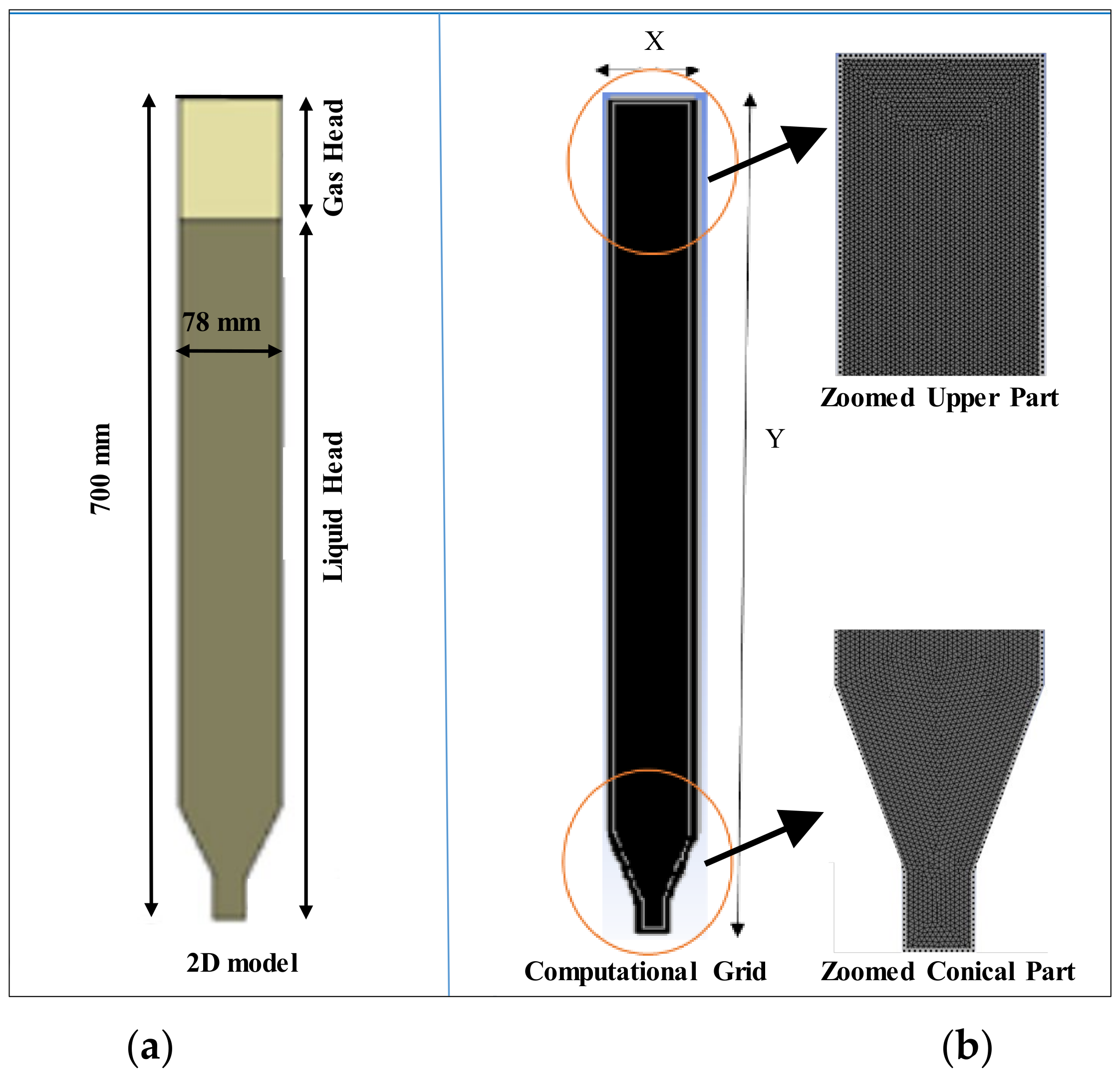
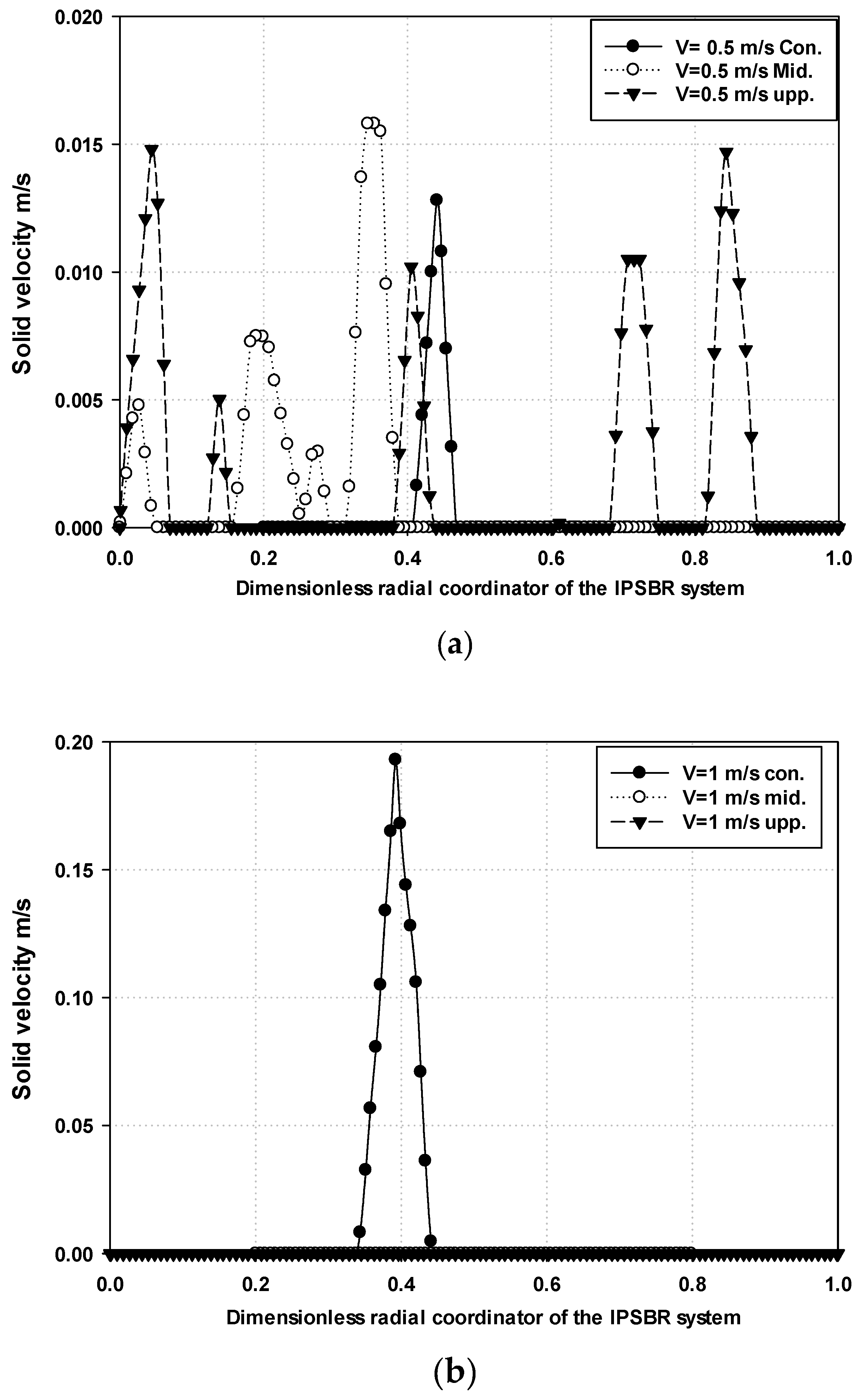
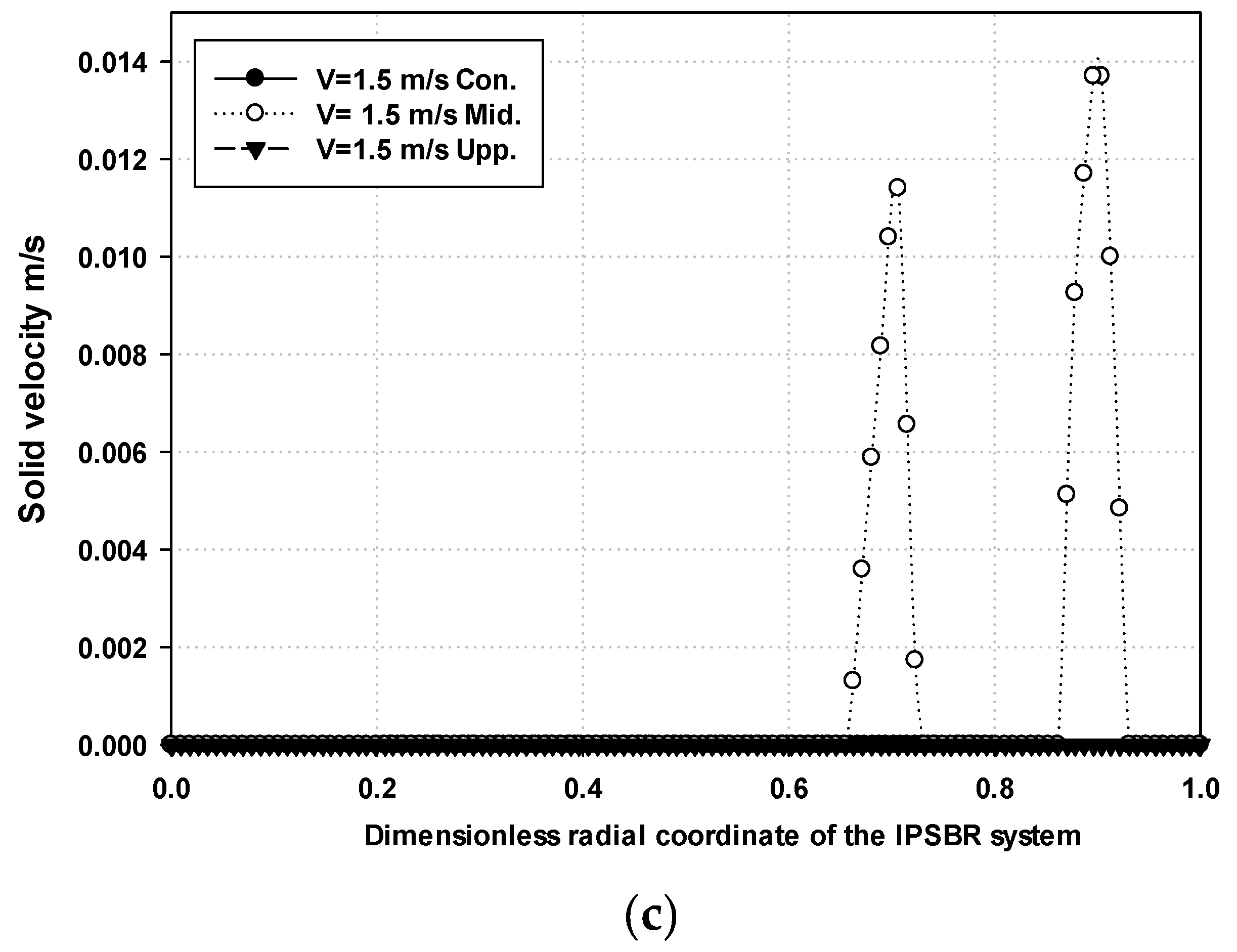

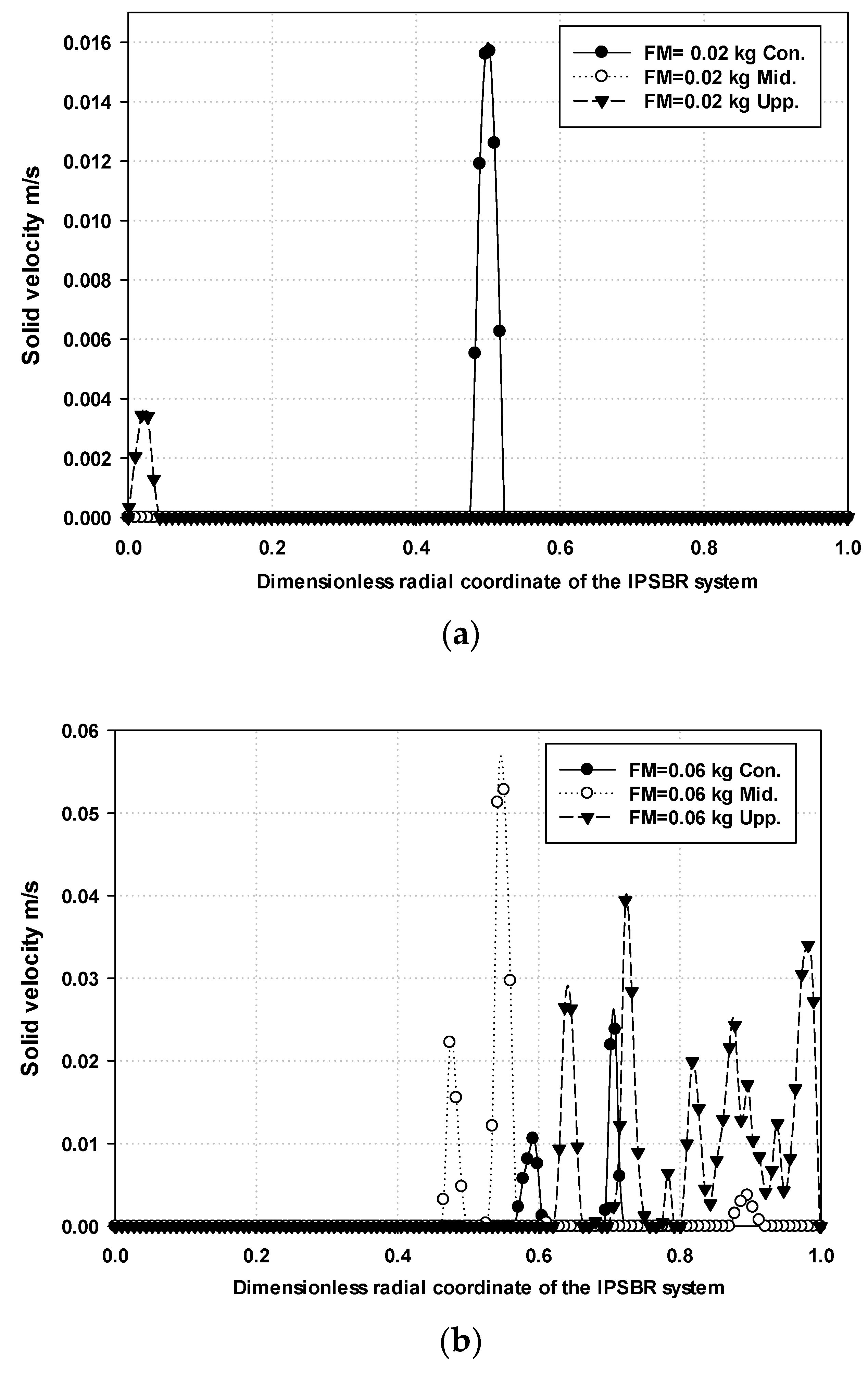
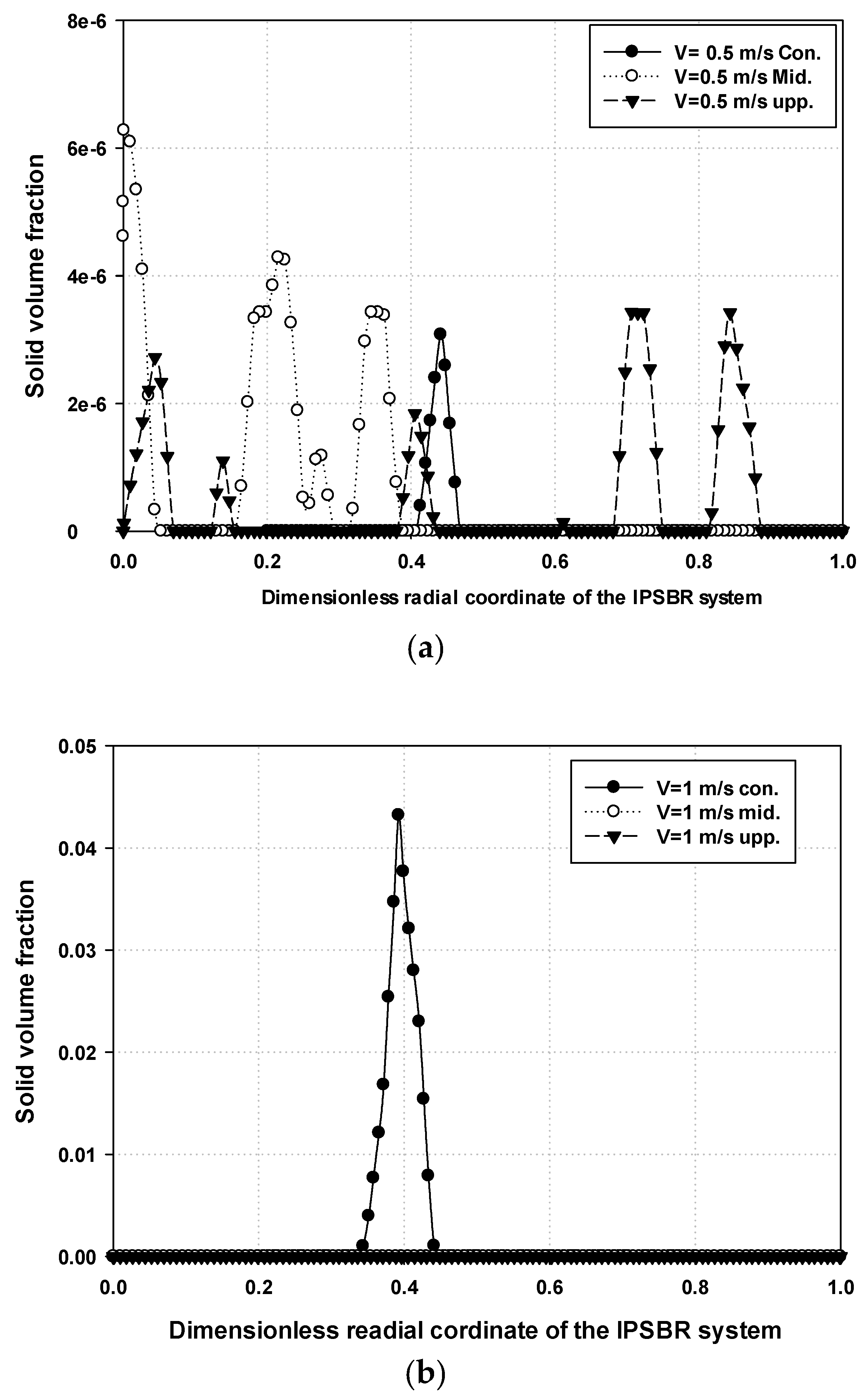
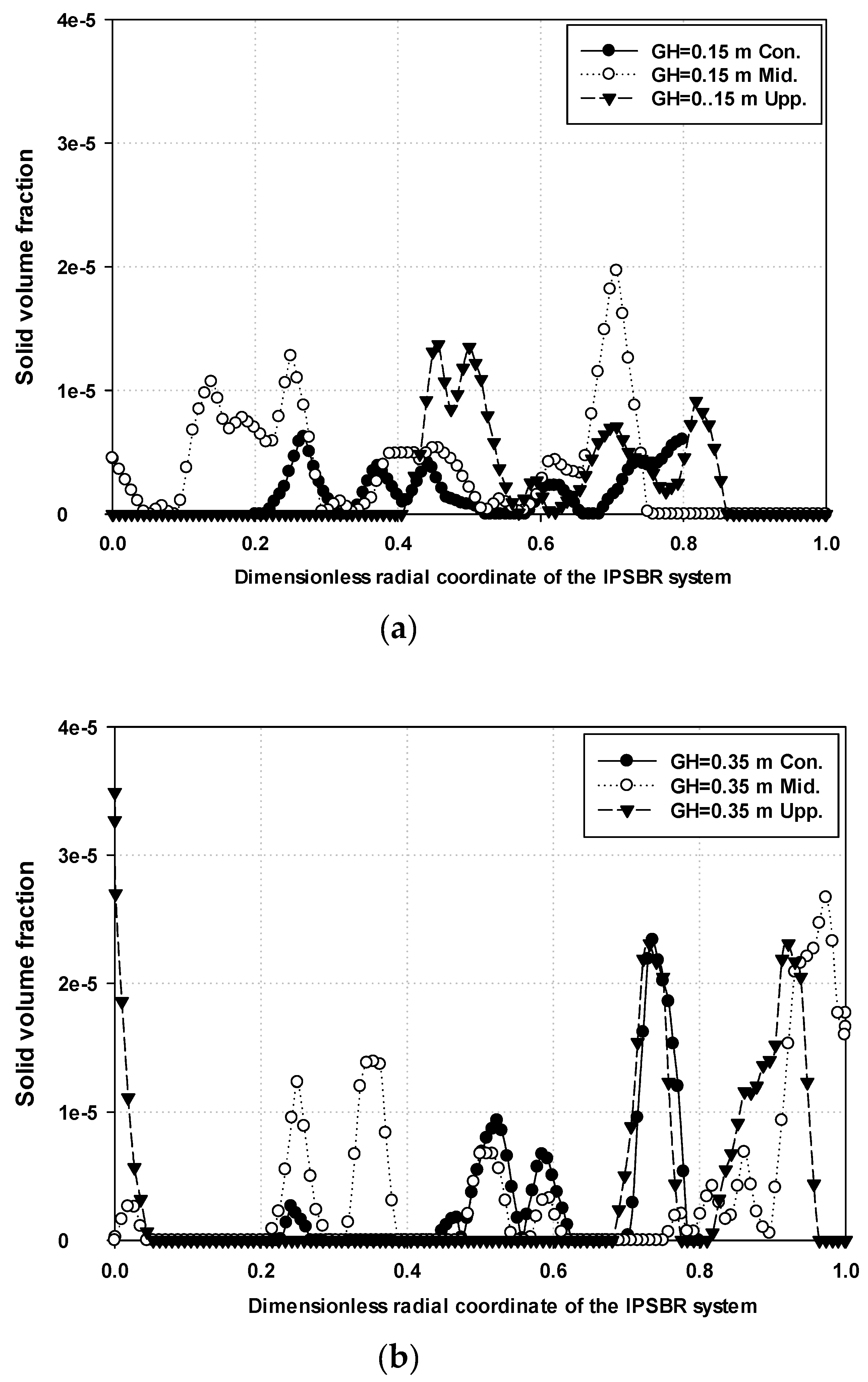

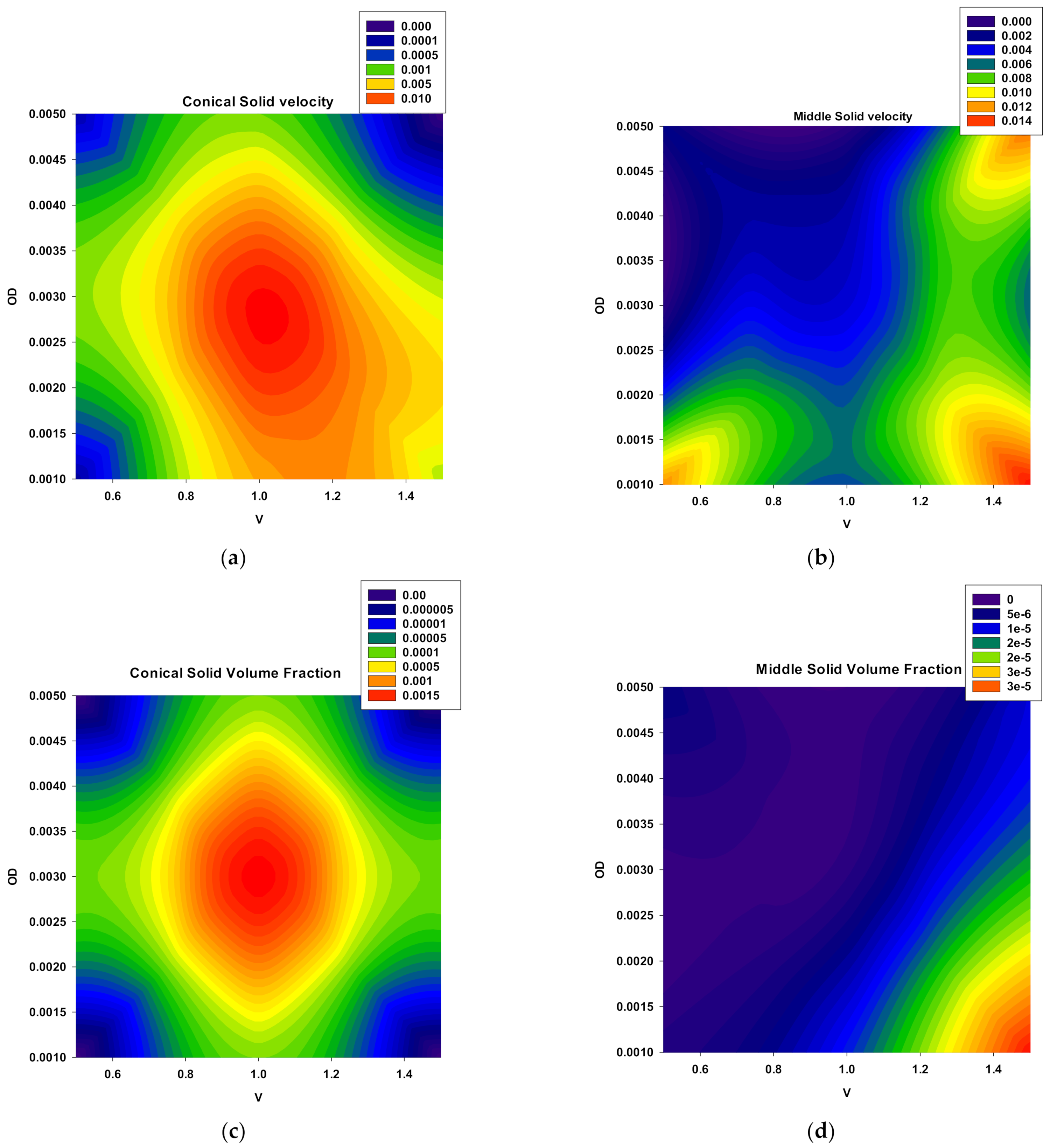

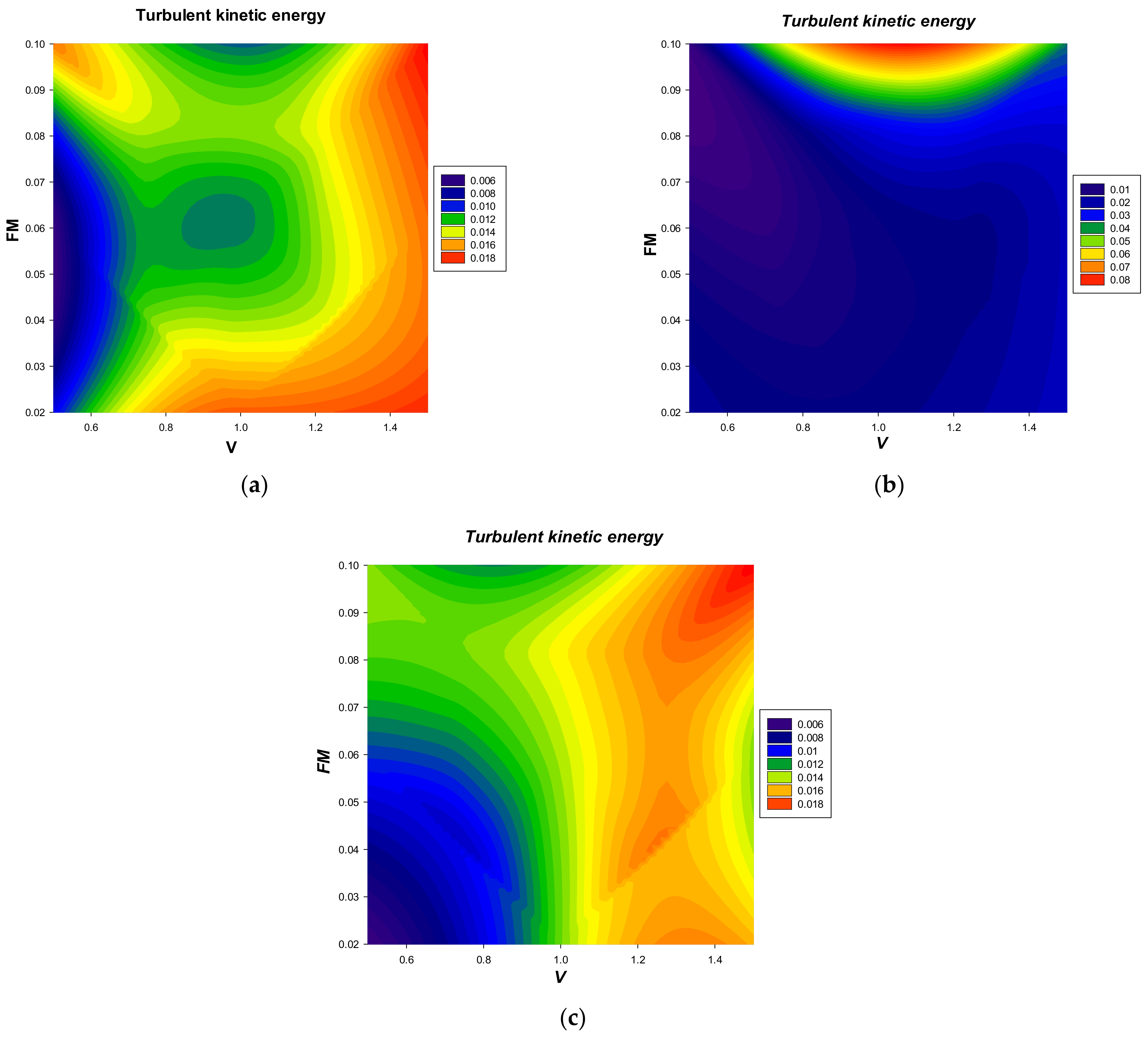

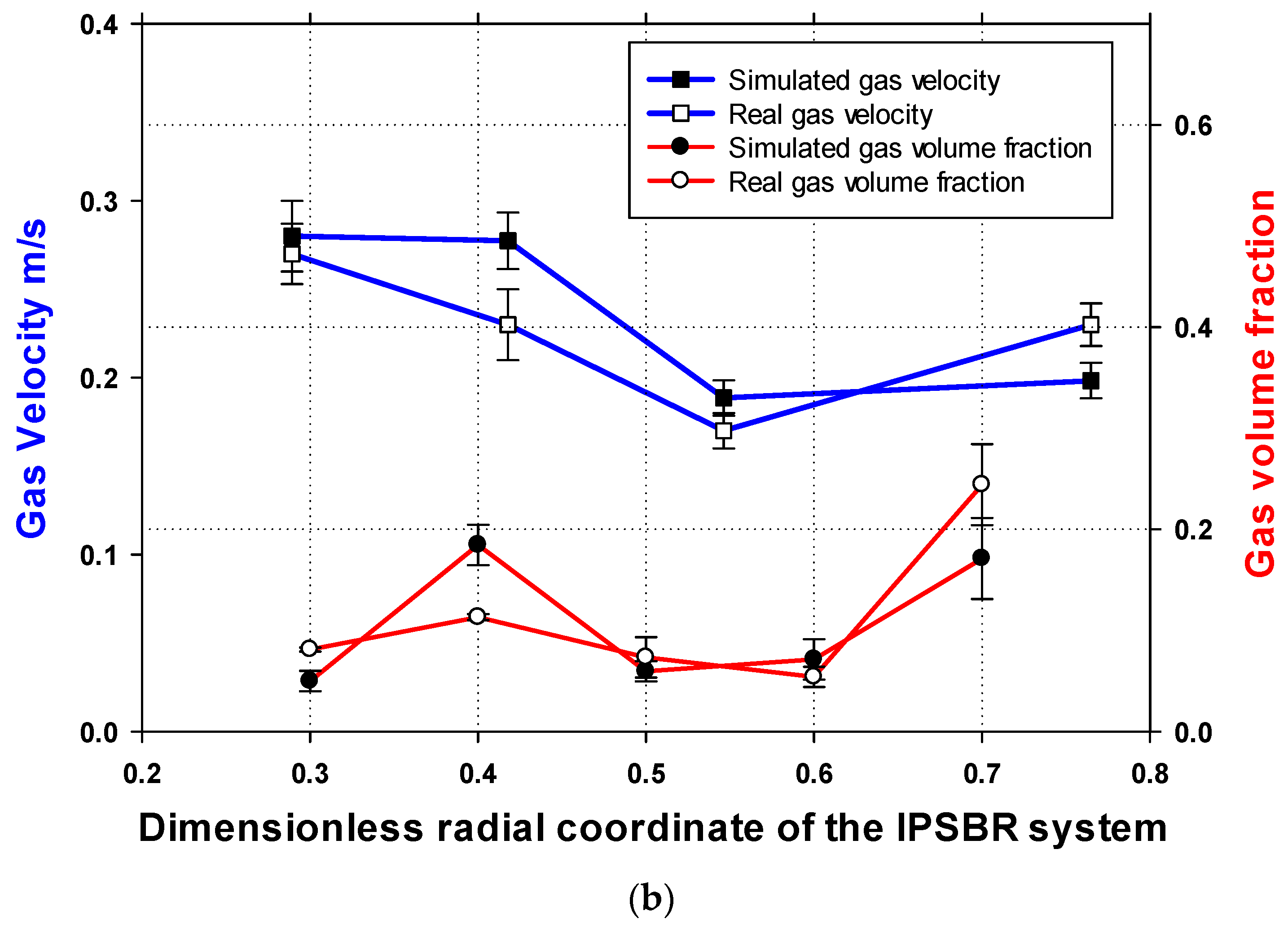
| Governing equations | |
| Continuity equation is given by [12,13] | |
| (1) | |
| Momentum equations is given by [26] | |
| (2) | |
| The stress tensor ( is given by [27] | |
| (3) | |
| (4) | |
| Transport Equations for the Standard k-ε Mode [28] Turbulence Kinetics Energy [29] | |
| (5) | |
| Turbulence Energy Dissipation Rate [28] | |
| (6) | |
| The eddy viscosity is obtained as | |
| = | |
| Where = 1.0, = 1.3, , = = 0.09 [27] | (7) |
| Newtonian equation of motion (to consider the effect of mixing particles) | |
| (8) | |
| g = 9.81 m/s2 | |
| For the Morsi and Alexander model [29]: | |
| = | (9) |
| = | (10) |
| = | (11) |
| where ,, and are constants that are employed for smooth spherical particles over several ranges of Reynolds number [30], which are defined as following: | |
| Levels | Feed Gas Velocity | Orifice Diameter | Gas Head | Diameter of Mixing Particles | Total Mass of Mixing Particles |
|---|---|---|---|---|---|
| Units | m/s | m | m | m | kg |
| Tag | V | OD | GH | DM | FM |
| Level −α | 0.5 | 0.001 | 0.15 | 0.009 | 0.02 |
| Level −1 | 0.75 | 0.002 | 0.2 | 0.0045 | 0.04 |
| Level 0 | 1 | 0.003 | 0.25 | 0.0135 | 0.06 |
| Level +1 | 1.25 | 0.004 | 0.3 | 0.018 | 0.08 |
| Level +α | 1.5 | 0.005 | 0.35 | 0.0225 | 0.1 |
| Source | DF | Adj SS | Adj MS | F-Value | p-Value | Significance |
|---|---|---|---|---|---|---|
| Model | 20 | 12.1582 | 0.60791 | 169.52 | 0.000 | Significant |
| Linear | 5 | 3.6904 | 0.73808 | 205.81 | 0.000 | Significant |
| V | 1 | 1.8090 | 1.80895 | 504.43 | 0.000 | Significant |
| OD | 1 | 1.4608 | 1.46079 | 407.34 | 0.000 | Significant |
| GH | 1 | 0.4042 | 0.40416 | 112.70 | 0.000 | Significant |
| DM | 1 | 0.0066 | 0.00663 | 1.85 | 0.201 | Non-significant |
| FM | 1 | 0.0098 | 0.00985 | 2.75 | 0.126 | Non-significant |
| Square | 5 | 3.3525 | 0.67050 | 186.97 | 0.000 | Significant |
| V*V | 1 | 0.7673 | 0.76726 | 213.95 | 0.000 | Significant |
| OD*OD | 1 | 2.3064 | 2.30639 | 643.14 | 0.000 | Significant |
| GH*GH | 1 | 0.6913 | 0.69125 | 192.76 | 0.000 | Significant |
| DM*DM | 1 | 0.0068 | 0.00685 | 1.91 | 0.194 | Non-significant |
| FM*FM | 1 | 0.0014 | 0.00144 | 0.40 | 0.539 | Non-significant |
| 2-Way Interaction | 10 | 5.1153 | 0.51153 | 142.64 | 0.000 | Significant |
| V*OD | 1 | 0.0066 | 0.00658 | 1.83 | 0.203 | Non-significant |
| V*GH | 1 | 0.6274 | 0.62742 | 174.96 | 0.000 | Significant |
| V*DM | 1 | 0.4969 | 0.49689 | 138.56 | 0.000 | Significant |
| V*FM | 1 | 0.0059 | 0.00594 | 1.66 | 0.225 | Non-significant |
| D*GH | 1 | 0.0076 | 0.00758 | 2.11 | 0.174 | Non-significant |
| OD*DM | 1 | 0.4368 | 0.43677 | 121.79 | 0.000 | Significant |
| OD*FM | 1 | 0.0195 | 0.01953 | 5.45 | 0.040 | Significant |
| GH*DM | 1 | 0.2610 | 0.26100 | 72.78 | 0.000 | Significant |
| GH*FM | 1 | 2.5187 | 2.51873 | 702.35 | 0.000 | Significant |
| DM*FM | 1 | 0.7349 | 0.73488 | 204.92 | 0.000 | Significant |
| Error | 11 | 0.0394 | 0.00359 | |||
| Pure Error | 5 | 0.000000 | 0.000000 | |||
| Total | 31 | 12.1977 | ||||
| Std. Dev. | 0.0598844 | |||||
| R-sq | 0.9968 | |||||
| R-sq (adj) R-sq (Pred) | 0.9909 0.9133 |
| Solution | V (m/s) | OD (m) | GH (m) | DM (m) | FM (kg) |
|---|---|---|---|---|---|
| 1.5 | 0.001 | 0.202 | 0.0107 | 0.02 | |
| R1 Fit | R2 Fit | R3 Fit | R4 Fit | R5 Fit | R6 Fit |
| 4.421 | 3.175 | 0.0001 | 0.00005 | 0.0001 | 0.000003 |
| R7 Fit | R8 Fit | R9 Fit | R10 Fit | R11 Fit | R12 Fit |
| 0.0225 | 0.0251 | 0.0012 | 0.235 | 0.3586 | 0.1285 |
| R13 Fit | R14 Fit | R15 Fit | |||
| 0.0806 | 0.0233 | 0.0029 |
| Predicted Responses (CCD Model) | Simulated Responses (Eulerian Model) | Unit | 95% Confidence Interval | Standard Error Deviation | |
|---|---|---|---|---|---|
| R1 | 4.421 × 10−6 | 3.883 × 10−6 | kg/cm3 | 3.824 × 10−6–5.29 × 10−6 | 0.38042 |
| R2 | 3.175 × 10−6 | 3.017 × 10−6 | kg/cm3 | 2.976 × 10−6–3.435 × 10−6 | 0.11172 |
| R3 | 1.0 × 10−10 | 8.1 × 10−11 | kg/cm3 | 6.0 × 10−11–1.7 × 10−9 | 1.3435 × 10−5 |
| R4 | 5.0 × 10−5 | 5.8 × 10−5 | - | 3.1 × 10−5–7.1 × 10−5 | 2.8284 × 10−6 |
| R5 | 1.0 × 10−4 | 7.3 × 10−4 | - | 6.0 × 10−5–1.8 × 10−4 | 0.00045 |
| R6 | 3.0 × 10−6 | 4.0 × 10−5 | - | 2.0 × 10−6–4.0 × 10−6 | 2.6163 × 10−5 |
| R7 | 0.0225 | 0.0177 | m/s | 0.0122–0.0361 | 0.00339 |
| R8 | 0.0251 | 0.0176 | m/s | 0.0113–0.0461 | 0.00523 |
| R9 | 0.0012 | 0.0010 | m/s | 0.00051–0.0031 | 0.00014 |
| R10 | 0.235 | 0.311 | - | 0.141–0.415 | 0.05374 |
| R11 | 0.3586 | 0.3491 | - | 0.1521–0.5201 | 0.00665 |
| R12 | 0.1285 | 0.1552 | - | 0.0411–0.236 | 0.01888 |
| R13 | 0.0806 | 0.0761 | m/s | 0.0581–0.142 | 0.00318 |
| R14 | 0.0233 | 0.0317 | m/s | 0.0147–0.0402 | 0.00594 |
| R15 | 0.0029 | 0.0041 | m/s | 0.0013–0.00561 | 0.00085 |
| Case | ||
|---|---|---|
| Detected Measurement | With Mixing Particles | Without Mixing Particles |
| Average simulated gas velocity (m/s) | 0.2361 | 0.2977 |
| Average experimental gas velocity (m/s) | 0.2250 | 0.2700 |
| Error deviation % | 4.701% | 9.319% |
| Average simulated gas volume fraction | 0.1072 | 0.0662 |
| Average experimental gas volume fraction | 0.1131 | 0.0704 |
| Error deviation % | 5.163% | 5.888% |
| Reference | Phase | Reactor Design | Validation Parameter | Error |
|---|---|---|---|---|
| Szafran et al. [44] | Gas-solid | Conical-base spouted bed | Fraction of gas bypassing to the annulus region. | 2–22% |
| Shi et al. [45] | Gas-solid | Conical-base spouted bed | Time-averaged axial solid velocity | ~1–30% |
| Yang et al. [46] | Gas-solid | Conical-base spouted bed | lateral profile of particle vertical velocity in the spout region | Simulations agree well with the experiments at all bed heights |
| Duarte et al. [47] | Gas-solid | Conical–cylindrical spouted bed | Minimum spout velocity | Deviation error of 3.8% |
| Kim et al. [4] | Gas-liquid | Bubble column: Cylindrical body with complex gas sparger configuration | Gas holdup, interfacial area, and mass transfer coefficient. | 1–8% |
| Current study | Gas, liquid, solid | Conical–cylindrical spouted bed | Averaged air velocity and air volume fraction | 5–10% |
Publisher’s Note: MDPI stays neutral with regard to jurisdictional claims in published maps and institutional affiliations. |
© 2021 by the authors. Licensee MDPI, Basel, Switzerland. This article is an open access article distributed under the terms and conditions of the Creative Commons Attribution (CC BY) license (https://creativecommons.org/licenses/by/4.0/).
Share and Cite
Mohammad, A.F.; Mourad, A.A.-H.I.; Al-Marzouqi, A.H.; El-Naas, M.H.; Bruggen, B.V.d.; Al-Marzouqi, M.H.; Alnaimat, F.; Al Musharfy, M. Comprehensive Optimization of the Dispersion of Mixing Particles in an Inert-Particle Spouted-Bed Reactor (IPSBR) System. Processes 2021, 9, 1921. https://doi.org/10.3390/pr9111921
Mohammad AF, Mourad AA-HI, Al-Marzouqi AH, El-Naas MH, Bruggen BVd, Al-Marzouqi MH, Alnaimat F, Al Musharfy M. Comprehensive Optimization of the Dispersion of Mixing Particles in an Inert-Particle Spouted-Bed Reactor (IPSBR) System. Processes. 2021; 9(11):1921. https://doi.org/10.3390/pr9111921
Chicago/Turabian StyleMohammad, Ameera F., Aya A.-H. I. Mourad, Ali H. Al-Marzouqi, Muftah H. El-Naas, Bart Van der Bruggen, Mohamed H. Al-Marzouqi, Fadi Alnaimat, and Mohamed Al Musharfy. 2021. "Comprehensive Optimization of the Dispersion of Mixing Particles in an Inert-Particle Spouted-Bed Reactor (IPSBR) System" Processes 9, no. 11: 1921. https://doi.org/10.3390/pr9111921






